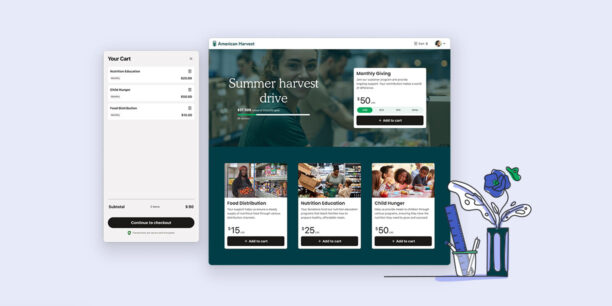6 Measurable Fundraising Goals To Consider for Your Nonprofit

Request a Demo
Learn how top nonprofits use Classy to power their fundraising.
Every fundraising campaign needs specific SMART goals. To measure fundraising success, most nonprofits typically choose a combination of the following key metrics:
- Raise $X
- Acquire X new donors and/or major donors
- Recruit X fundraisers
It’s important to focus on these metrics when tracking your fundraising efforts. However, there are other metrics you should also consider to take your organization’s fundraising strategy to the next level.
Here are six specific fundraising goals that can help your organization succeed in the long run.
1. Raise Brand Awareness
While fundraising campaigns are primarily intended to raise funds toward a financial goal, perhaps you’ll want your next campaign to help raise brand awareness as well. Focusing your efforts to increase reach, boost engagement, and get the word out about your cause can introduce new potential donors to your organization who may turn into lifetime supporters.
You’ll want to spread the word about your fundraising activities through social media. Assess your reach and engagement through the number of likes, retweets, comments, and shares your social posts garner.
Another way to measure the success of your outreach is by looking at the number of new email subscribers you acquire throughout your campaign. Because your social media posts will direct people back to your website, you can track the growing interest in your organization by identifying the number of people who decide to sign up for your updates or newsletter.
2. Acquire New Recurring Donors
Recurring giving is a critical element of nonprofit fundraising. Recurring donations contribute to increased donor retention rates, annual donation volume, and revenue predictability. Focusing a future campaign on acquiring new recurring donors is a strategic way to scale your impact and ultimately raise more for your mission.
To track your progress toward this objective, you need first to determine how many current donors are giving on a recurring basis. Then, think about how you can grow this donor segment.
Naturally, you can increase your numbers by upgrading one-time donors to recurring givers. An annual donor may have given several one-time gifts to your organization over the years, but proposing the idea to break their annual gift up into weekly, monthly, or quarterly donations could be a great way to initiate the upgrade process.
You can also focus on recapturing lapsed recurring donors. Depending on their reason for leaving, these donors might be easier to bring back into the fold. It could be as simple as asking them to update their expired credit card information.
3. Increase Your Average Recurring Donation Amount
Another way to achieve growth through recurring gifts is to increase your donors’ average gift size by a set dollar amount. Let’s say, for instance, you have 100 recurring donors. If the current average monthly gift amount is $15, you might aim to increase it to $18.
Reach out to your individual donors and thank them for their support. Calling them or meeting in person would be ideal, but if this isn’t feasible, send a personalized letter or email at the very least.
Let your supporters know how much they’ve impacted your organization and how their involvement is helping to advance your mission. Then, ask them to consider increasing their recurring donation amount. Explain how adding just one extra dollar to their gift can greatly enhance your organization’s long-term planning and budgeting for the programs they’re passionate about.
Download the Ultimate Guide to Recurring Giving
4. Increase Your Average One-Time Gift Size
On the flip side, your fundraising team might be focused on boosting the average gift size of all one-time donors. One way to do this is to alter and test suggested giving levels on your donation forms.
Experiment with slightly increasing your default gift amounts, and see whether the average gift size received increases by the end of your campaign. Keep in mind that different donors have different giving capacities, so you should have custom donation forms with suitable default gift ranges for each donor segment.
Divide your donors by past average gift amount (e.g. low-tier donors, mid-tier donors, high-tier donors), then direct them to a custom donation form with giving levels tailored specifically to them. This allows you to upgrade each level of donor according to their true giving range.
5. Grow the Number of Gifts Received Per Communication Channel
A common and important campaign goal is to acquire a certain number of gifts. Instead of focusing on just that number alone, consider focusing a portion of your efforts on increasing the number of gifts that come in through each communication channel.
This approach can help you better understand which channels are driving the highest conversion, and therefore spark conversation about how to strengthen each one as an avenue to acquire donations.
Track your progress by first determining the average number of gifts that come in through each channel. Then create a custom donation form for each channel so you can track how many gifts it captures over the course of a time-based campaign.
Your website donate button, email appeals, social media asks, and newsletters can each link to a separate donation form.
Read Next: 10 Marketing Lessons for All Nonprofits
6. Boost Your Email Conversion Rate
Use your next fundraising initiative as an opportunity to test different types of emails. Understanding which type resonates most with your audience can help you better engage new and existing donors and maximize returns.
To test a certain variable, split your donor base into separate groups, send each segment a different version of your email campaign, and compare which version performs better. Here are a few variables you might consider testing:
- Email subject lines
- Type of images included in the email
- Type of donate button (shape, color, copy, placement)
- Plain text versus HTML-formatted
- Storylines
Tailor your organization’s set of goals to reflect the specific metrics you want to reach. Rather than focusing solely on raising more and acquiring new donors, you can also measure your nonprofit’s success by looking at the numbers that make up the bigger picture.
Boost Future Fundraising Campaigns With Measurable Goals
From expanding your recurring giving program to optimizing your next set of email appeals, these measurable goals can help you grow your community, uplevel your organization’s engagement strategies, and increase your annual fundraising levels.

Why America Gives 2022: Finding Resilience Through Donor Loyalty
Subscribe to the Classy Blog
Get the latest fundraising tips, trends, and ideas in your inbox.
Thank you for subscribing
You signed up for emails from Classy
Request a Demo
Learn how top nonprofits use Classy to power their fundraising.
 Explore Classy.org
Explore Classy.org 

